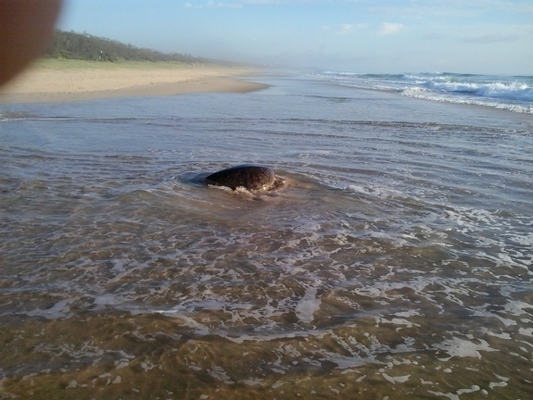By Margaret Maccoll
Only about three per cent of turtle nests hatch during daylight hours so it was a rare occurrence last week when a Double Island Point resident spotted some hatchlings making their frantic dash to the ocean on Noosa North Shore.
The resident stopped their car and flagged down oncoming 4WDs so the hatchlings could make their way safely to the ocean.
Cooloola Coast Care president Randy Owen said this was the second year the group had monitored turtle nests from Rainbow to Inskip Point where there had this season been 34 turtle nests but little was known about the turtle nesting on Noosa North Shore.
“There’s about a dozen nests we know of there. We don’t patrol the beach regularly but we encourage people if they see turtles to take photos and send GPS coordinates. We have a couple of volunteers who make the trip to watch the nests if they’re close to running,“ he said.
Randy said group members found one nest below the high tide line and moved it to higher ground and two women chased away a goanna snacking on a nest and managed to lead six or seven turtles safely to the ocean.
Turtle researcher of 50 years Dr Col Limpus told the group any data they could record on the turtles nesting from Sandy Cape to Noosa North Shore would be valuable.
The volunteers are trained at Mon Repos Turtle Centre to monitor the turtles.
“It takes a lot of work to dig up a nest,“ Randy said.
Last week when they dug up a nest they discovered out of its 152 turtle eggs 141 turtles had survived.
“This nest was just down on the high tide mark. It would have had hundreds of vehicles drive over it,“ he said.
Randy said the nest was 60cm or deeper and because of its large size and depth would have been made by a big turtle.
“There were car tracks right next to the nest. The hatchlings struggled to climb up the tyre tracks and kept falling backwards.“
Randy said the turtles climb on top of each other as they make their way to the top of the nest before making the run to the ocean together.
“In 20 minutes it’s all over. It’s a tough ride for them,“ he said.
With loggerheads listed an endangered species and green turtles threatened Randy said the group’s volunteers records of the turtles, their nests and the unhatched and undeveloped eggs remaining after the run formed an important part of their data collection.
He said the small hatchlings have enough energy to paddle to the water and swim out until they reach the currents where they float on their journey across the oceans, eating what comes their way. About 30 years later they return to lay their own eggs on the same beach.
Only about one in a thousand turtles makes it to maturity, he said.
The Department of Environment and Science issued a warning last Friday to drivers on the beach to be aware of hatchling emerging from their nests.
Drivers should also be aware that taking their vehicle above the high tide mark or into dunes increases the risk of driving over turtle nests, compacting nests and causing erosion leading to loss of eggs, they said.
Randy urged motorists particularly those on the beach at night to keep an eye out for hatchlings or turtles looking for a place to nest.
“Kill the headlights and just wait,“ he said.
“Lights will spook (the adults). If they don’t find a place to lay their eggs they may not lay them. If they see hatchlings just stop and warn others.“
The hatchlings are attracted to light, a reflection of the moon on the water, to lead them to the ocean and can be waylaid by headlights, but people could use torchlight to lead them to the ocean if this occurred.For more information visit www.cooloolacoastcare.org.au






